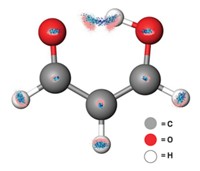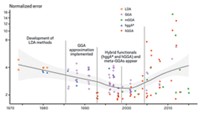Advertisement
Grab your lab coat. Let's get started
Welcome!
Welcome!
Create an account below to get 6 C&EN articles per month, receive newsletters and more - all free.
It seems this is your first time logging in online. Please enter the following information to continue.
As an ACS member you automatically get access to this site. All we need is few more details to create your reading experience.
Not you? Sign in with a different account.
Not you? Sign in with a different account.
ERROR 1
ERROR 1
ERROR 2
ERROR 2
ERROR 2
ERROR 2
ERROR 2
Password and Confirm password must match.
If you have an ACS member number, please enter it here so we can link this account to your membership. (optional)
ERROR 2
ACS values your privacy. By submitting your information, you are gaining access to C&EN and subscribing to our weekly newsletter. We use the information you provide to make your reading experience better, and we will never sell your data to third party members.
Materials
Most-cited chemistry papers published a decade ago
C&EN and CAS look back at high-impact molecular research from 2006
by Lauren K. Wolf
December 15, 2016
| A version of this story appeared in
Volume 94, Issue 49

Title: Graphene-based composite materials
Reference: Nature, DOI: 10.1038/nature04969
Number of citations: 6,196
Senior authors: SonBinh T. Nguyen and Rodney S. Ruoff
Affiliation in 2006: Northwestern University
Description of work: Ruoff had predicted that graphene sheets, or flakes, could be used as “filler” in electrically conducting polymer composites. The problem was that these flakes only dispersed in water-based solutions, making their incorporation into organic polymers difficult. So, along with Nguyen and coworkers, Ruoff reported in 2006 a method to chemically modify flakes of graphene oxide and disperse them in polymers such as polystyrene.
Impact of work: “I think the paper has been highly cited because others have learned that dispersing graphene into various matrix materials has led to a range of composites with interesting properties,” says Ruoff, who is currently at Ulsan National Institute of Science & Technology. “For example, there are now commercial products such as polymer fibers with small percentages of graphene flake mixed in that have significantly improved mechanical properties.”

Title: Induction of pluripotent stem cells from mouse embryonic and adult fibroblast cultures by defined factors
Reference: Cell, DOI: 10.1016/j.cell.2006.07.024
Number of citations: 7,384
Senior authors: Kazutoshi Takahashi and Shinya Yamanaka
Affiliation: Kyoto University
Description of work: Up until 2006, scientists studying human development and regenerative medicine could source pluripotent stem cells only from embryos—an ethical dilemma for many. That year, Yamanaka and Takahashi changed everything: They reported a method to convert human skin cells into stem cells capable of transforming into any type of cell in the body. These “induced pluripotent stem cells” (iPSs), created by activating just four genes, earned Yamanaka the 2012 Nobel Prize in Physiology or Medicine.
Impact of work: A citation on nobleprize.org states that “Yamanaka’s discovery has opened up a completely new research field, and the astonishingly simple iPS technology is now used in a large number of laboratories around the world.”

Title: Semiempirical GGA-type density functional constructed with a long-range dispersion correction
Reference: J. Comp. Chem., DOI: 10.1002/jcc.20495
Number of citations: 7,480
Senior author:Stefan Grimme
Affiliation in 2006: University of Münster
Description of work: Computational chemists use density functional theory (DFT) to calculate the electronic structure of multiatom systems. In 2006, this method didn’t work well for large molecules and condensed matter such as organic solids and liquids. In this paper, Grimme reported a fix for the problem: He developed a correction that could describe long-range dispersion interactions such as van der Waals forces between atoms. It enabled, among other things, DFT to more accurately simulate water and crystalline forms of drugs.
Impact of work: It wasn’t a particularly clever idea, but it was the first paper to make the correction in a “generally useable way,” says Grimme, who is now at the University of Bonn. “The other reason it’s so heavily cited is that widely used quantum chemistry software packages implemented this functional in their code rather early on.”
Source: To count citations, CAS, a division of the American Chemical Society, performed a search of its CAplus database using its STN search tool in mid-December 2016.
C&EN's YEAR IN REVIEW
Top Headlines of 2016
- Hawaii explosion cost a researcher an arm
- TSCA reform crossed the finish line
- U.S. elected Trump as president
- The periodic table got four new elements
- Post Dow-DuPont, chemical deal-making waned as 2016 advanced
- Labs made advances in Zika research
- Four ag giants to rule them all
- 2016 Nobel Prize in Chemistry at a glance
- Brexit bomb exploded
- Focus returned to Iran's chemical industry
- Overtime pay limit doubles under Obama administration
- The CRISPR craze continued
- Perfluorinated compounds got increased scrutiny
- From the lab to the market
- Paris Agreement to curb climate change took off
- World chemical production at a glance
- Flint's water woes lingered
- As China's economy slowed, chemical makers adjusted
- Mostafa A. El-Sayed won the 2016 Priestley Medal
- ACS members on average fared better than young graduates in employment surveys
- ACS invests internationally
- Spun-off firms found their footing in 2016
- Remembering the Nobel laureates we lost in 2016
- ACS proposed chemistry preprint server
- Berkeley College of Chemistry avoided reorganization
- Fight against opioid epidemic continued in 2016
- Noble gas shortages averted, for now
- The shale gas boom by the numbers
- Crop protection products in the crosshairs
- ACS launched new journals
- Website search terms of the year
- Biobased materials hit the big time
- No better deal emerged for Mossville, La.
- U.S. prepares for national food labeling standard
Top Research of 2016
- Mini factory made drugs on demand
- World's first PET-munching microbe discovered
- Liquid metals went to work
- Methylene activation reached new heights
- Biological structures of the year
- Wearable sensors were 'the' fashion accessories of 2016
- Scientists beefed up the antibiotic arsenal
- An enzymatic route to carbon-silicon bonds
- Single-atom catalysts gained a toehold
Revisiting Research of 2006





Join the conversation
Contact the reporter
Submit a Letter to the Editor for publication
Engage with us on Twitter